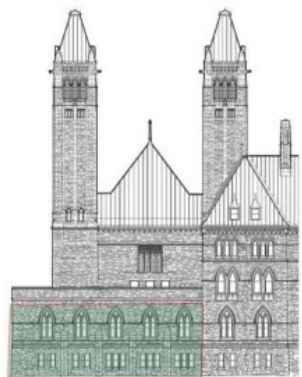David Edgar and Kate Westbury
i Lead Conservator for the Centre Block Rehabilitation Program, PCL-Ellis Don, david@declheritage.ca
ii Heritage and Approvals Lead for the Centre Block Rehabilitation program, Public Services and Procurement Canada, kate.westbury@tpsgc-pwgsc.gc.ca
ABSTRACT
The Centre Block (CB) is a Classified Federal Heritage Building housing Canada’s Parliament. Nearly a century after opening, it closed in 2019 for rehabilitation. The requirements of the Centre Block Rehabilitation Project (CBRP) include major structural, seismic and security upgrades, while prioritizing the preservation of the building’s heritage character and materials. Lessons learned during the rehabilitation of other buildings in the Parliamentary Precinct led to the adoption of an integrated approach to conservation, using “Design Assist” to bring conservation specialists – under contract to the Construction Manager (CM) – directly into a role that combines design and construction activities. The conservation of the exterior stonework forms a major part of the project scope and the chosen “level of clean” must address multiple challenging factors: technical and regulatory conservation requirements; Client/Stakeholder expectations; public perception; construction budget and schedule. The CM team reviewed existing masonry materials reference documentation and testing results, including the nature of the soiling to be removed by laser cleaning. A gap analysis exercise then identified any additional testing requirements. A program of trials was developed whereby every contractor/supplier with previous laser cleaning experience on Parliament Hill carried out three small trials in discreet locations on the CB building. Each contractor supplied three different levels of clean. The processes and outcomes were carefully managed by the Heritage Leads from the Client (Public Service and Procurement Canada), the Consultant (CENTRUS) and the CM (PCL/ED). The Client engaged various project stakeholders and representatives of applicable regulatory bodies to review the results of the trials on site. Testing was carried out to determine changes in surface morphology, colour, and moisture movement properties. Every stage in the process and every decision was evaluated by the collaborative team and rigorously documented. The trials, analysis and reporting fed into the development of specifications and tender documents. The suppliers who carried out trials on site were evaluated and pre-qualified to bid on the larger scope of work. The CBRP’s innovative “Design-Assist” project approach encouraged input from craftspeople, equipment suppliers, designers, client(s), the CM, conservators and material scientists, resulting in a genuinely holistic approach to architectural conservation. The design-assist led cleaning trials have contributed to a successful construction phase, with minimal need for variations to scope, budget or schedule.
KEYWORDS: Laser ablation, masonry conservation, stone cleaning, sandstone, gothic architecture, analysis.
062-Edgar.pdf



